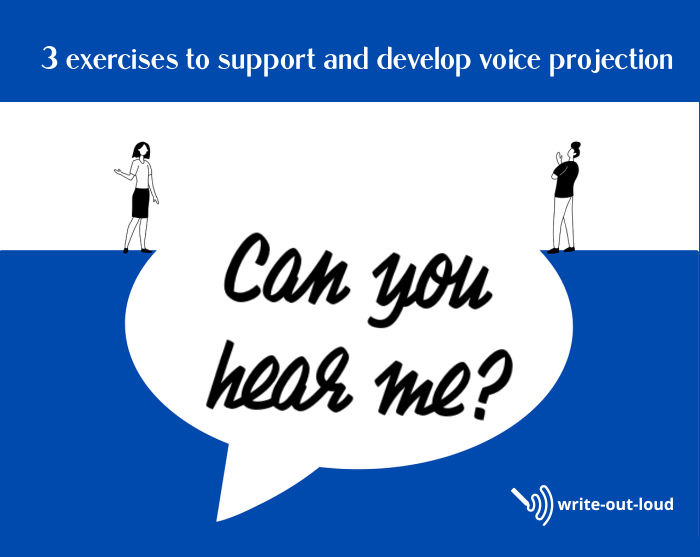Do you get complaints that nobody past the two front rows can hear you when you stand up to speak?
Speaking too quietly, or too softly, regularly tops the list of problems people want fixes for in public speaking.
The answer is not necessarily a microphone. In many circumstances you simply don't need one IF you learn to project your voice.
This does not mean yelling or shouting. If you shout continuously not only, will you ruin your voice, but you'll also lose your audience. No one enjoys being harangued at full volume.
Three exercises to support and develop voice projection
Do these regularly and the 'I can't hear you, speak up!' comments will become history.
The first two: Rag Dolls and Yawning are for releasing tension. (You can find them, and several more, on this page of vocal warm-ups.)
How wound up are you? Often a little voice is the result of being nervous.
Being nervous naturally causes us to tense up. And if you're tense, you can't project your voice. If you can't project your voice, you can't be heard and if you can't be heard that makes you more anxious, which in turn makes you more tense... It’s a vicious circle.
The third, Progressive Distancing will teach you how to increase your volume without strain.
Rag Dolls
Stand with your feet a shoulder width apart, breathe in through the nose and bending from the waist allow yourself to flop like a rag doll while breathing out through your mouth.
Shake any tension out of your arms, neck, shoulders and allow yourself to literally hang loose.
And then breathing in through your nose very gently and slowly bring yourself upright and breathe out through your mouth.
Repeat two or three times.
Yawning
Yawning releases tension in the jaw allowing you to open and use your mouth easily.
Open your mouth as wide as you can while saying 'ah' until all your breath is gone. Repeat several times.
Do not force the sound and gently massage any residual tension away.
Progressive Distancing
To do this exercise properly you must breathe well. (Click to find full instructions on breathing to support your voice.)
Learning to use your diaphragm to regulate the flow of air required for volume will make yelling to be heard, (and wrecked vocal cords), a thing of the past.
Once you're sure your breathing is the best it can be, begin.
If you can, stand, and start with speaking to something/anything right in front of you: for instance, your screen or a picture on your desk.
Say whatever you like to it: a simple greeting (Hello Bob), part of a speech you're practicing, or read a small passage from a book.
Then keeping your breathing even and relaxed take several steps back. Repeat the greeting, speech segment or reading without strain.
Now do it again and again; each time getting further and further away from whatever you are speaking to while maintaining clarity, pitch and tone. As the distance increases, so too does the amount of air you expel on the out-breath to get the volume you want.
Click to find more about voice projection.
That’s it for this week!
Aroha nui,
Susan
PS. If you found this beneficial, feel free to share it and click the ❤️ button so more people can discover it on Substack. 🙏Thank you.
PPS. As I said last week, and I’ll say next, if you have ideas for topics you’d like to see covered in this newsletter, or if you’d like to share an article on some aspect of public speaking, or a speech of your own, please get in touch. Either reply to this email or contact me through the form on my about me page on my website. I’d love to hear from you!
PPPS. For more articles about public speaking and presenting I recommend reading Damien Gauthier’s Impactful Speaking. Here’s his last one which is full of useful, easily implemented tips.




